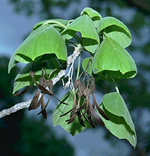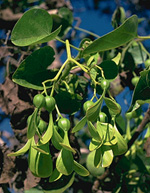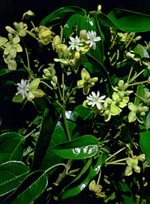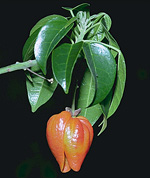 |
The Hernandiaceae are a small, primitive family, found in the tropics of all continents. In Australia, two genera are found in lowland rain forests in Queensland, from the vicinity of Brisbane to Cape York, while a third is found in monsoonal savannahs from the Kimberley region of Western Australia to south-east Queensland.
Characteristic features of the family Hernandiaceae in Australia include: - trees with simple, alternate leaves, sometimes with small, translucent oil-dots
- flowers bisexual or unisexual, sometimes in a cluster surrounded by bracts, with 4-10 perianth parts borne in 1 or two whorls
- female flowers with 8-10 perianth parts and an inferior ovary; male flowers with 6-8 perianth parts and 6-8 stamens which often have glandular nectary-appendages on the filaments
- fruit dry, indehiscent, winged or enclosed by the enlarged, fleshy bracts
Description
Evergreen or deciduous trees, or shrubs, or rarely woody or herbaceous vines climbing by twining or scrambling stems. Internal secretions not obvious. Plants glabrous or with simple, clavate, capitate or vesicular glandular or non-glandular, unicellular hairs. Leaves alternate and spiral, or distichous, petiolate or peltate. Stipules and stipellae absent. Lamina simple or once compound, ternate, symmetric; lamina/lobes lanceolate, ovate, elliptic, oblanceolate, obovate or oblong; base cuneate or rounded; margins entire, ±flat; venation pinnate, or palmate, with the midrib conspicuous, and the tertiary venation reticulate; surfaces punctate or not; herbaceous or leathery. Male and female flowers occurring on the same plant, or with all the flowers bisexual or occurring together with male flowers. Inflorescences terminal or axillary, consisting of capitula, glomerules, panicles or cymes, corymbs or thyrses. Bracts present or absent. Pollination by insects. Flowers sessile or stalked. Floral disc present; nectaries present on the stamens. Perianth regular, of 1 whorl only or all whorls ±similar, with 4–10, free, sepaloid and/or petaloid segments, imbricate in bud; inner perianth segments herbaceous, green; outer perianth segments white, cream or brown; all segments without contrasting markings, papery or membranous. Fertile stamens 3–7, alternating with and free of the perianth segments, free of the ovary and style, distinct from each other, all ±equal. Anthers basifixed, not versatile, opening sideways by longitudinal slits or by valves, 2-celled. Ovary inferior. Carpel 1; ovary with 1 locule. Style terminal, single and unbranched. Ovule 1, sessile; placentation apical. Fruit a dry or apparently fleshy indehiscent nut; the perianth on the maturing fruit deciduous, dry and persistent or growing larger. Disseminule macro-surface featureless or winged; micro-surface ±smooth, white, pink, brown or black, glossy or dull. Seeds 1 per fruit. Aril absent. Cotyledons 2. Embryo straight.
(Note: this description has been generated from the coded data compiled for the key. Any errors in the key data will be reflected in the descriptions.)
A treatment of the family Hernandiaceae has not yet been published in the Flora of Australia. It will appear in Volume 2.
Australian genera of Hernandiaceae (as recognised for the Flora of Australia)
Gyrocarpus
Hernadia
Valvanthera

|
  |

Gyrocarpus americanus (fruits)
Photo: H.Nicholson © H. & N. Nicholson

Gyrocarpus americanus (fruits)
Photo: M.Fagg © M.Fagg

Hernandia bivalvis (flowers)
Photo: G.Leiper © G.Leiper

Hernandia bivalvis (fruit)
Photo: H.Nicholson © H. & N. Nicholson

|

| |